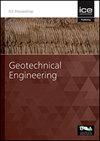A practical procedure for determining soil parameters of peat for finite element analysis using the cam clay model
IF 1.7
4区 工程技术
Q3 ENGINEERING, GEOLOGICAL
Proceedings of the Institution of Civil Engineers-Geotechnical Engineering
Pub Date : 2023-11-10
DOI:10.1680/jgeen.22.00063
引用次数: 0
Abstract
This paper presents a practical procedure for determining soil parameters used when analysing the deformation of peat ground by finite element analysis (FE analysis) using the Cam clay model. In practice, FE analysis has not been used frequently to predict the deformation of peat ground, even though FE analysis can be a powerful tool for its prediction. The main reason is that a practical method for determining parameters has not been established. In this paper, firstly, the remarkable correlation between the soil parameters required for FE analysis using the Cam clay model and the natural water content (w n ) and ignition loss (L i ), respectively, of peat and organic clay is presented. Next, based on this correlation, a flowchart for determining the soil parameters of peat and organic clay is proposed. By using this chart, it is possible to directly determine the soil parameters from triaxial compression, oedometer and other detailed tests or to estimate the soil parameters from w n , L i and other physical indexes. We also conducted a trial embankment on peat ground in Hokkaido, Japan. FE analysis was performed on the trial embankment using the proposed procedure for determining soil parameters. The results of the FE analysis corresponded to the measured settlement behaviour in the trial embankment with an accuracy in the range of −4% to +8%. The FE analysis results also expressed the measured behaviour of pore water pressure and lateral and vertical displacement in the trial embankment very well.确定泥炭土参数的实用程序,用于用凸轮粘土模型进行有限元分析
本文介绍了用Cam粘土模型进行泥炭地变形有限元分析时,确定土壤参数的实用方法。在实践中,尽管有限元分析是预测泥炭地变形的有力工具,但有限元分析并没有经常被用于预测泥炭地的变形。主要原因是尚未建立一种确定参数的实用方法。本文首先提出了用Cam粘土模型进行有限元分析所需的土壤参数分别与泥炭土和有机粘土的天然含水量(w n)和燃失量(L i)之间的显著相关性。其次,基于这种相关性,提出了泥炭和有机粘土土壤参数的确定流程图。利用该图,可以直接从三轴压缩、测径仪等详细试验中确定土壤参数,也可以从wn、li等物理指标中估算土壤参数。我们还在日本北海道的泥炭地上进行了试验路堤。利用提出的确定土壤参数的程序对试验路堤进行了有限元分析。有限元分析的结果与试验路堤的实测沉降行为相对应,精度在−4%至+8%之间。有限元分析结果也很好地表达了试验路堤孔隙水压力、侧向位移和竖向位移的实测特性。
本文章由计算机程序翻译,如有差异,请以英文原文为准。
求助全文
约1分钟内获得全文
求助全文
来源期刊
CiteScore
4.40
自引率
4.50%
发文量
68
审稿时长
3 months
期刊介绍:
Geotechnical Engineering provides a forum for the publication of high quality, topical and relevant technical papers covering all aspects of geotechnical research, design, construction and performance. The journal aims to be of interest to those civil, structural or geotechnical engineering practitioners wishing to develop a greater understanding of the influence of geotechnics on the built environment.

 求助内容:
求助内容: 应助结果提醒方式:
应助结果提醒方式:


